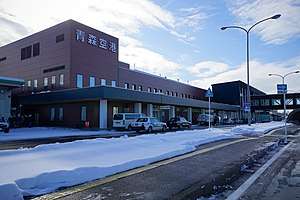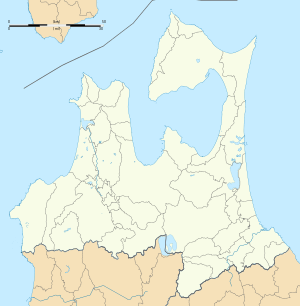Aomori Airport
Aomori Airport (青森空港, Aomori Kūkō) (IATA: AOJ, ICAO: RJSA) is an international airport located 11.2 km (7.0 mi) south southwest of Aomori Station[2] in Aomori, the capital city of Aomori Prefecture in northern Japan.
Aomori Airport 青森空港 Aomori Kūkō | |||||||||||
|---|---|---|---|---|---|---|---|---|---|---|---|
 | |||||||||||
| Summary | |||||||||||
| Airport type | Public | ||||||||||
| Operator | Aomori Prefecture | ||||||||||
| Location | Aomori, Japan | ||||||||||
| Elevation AMSL | 650 ft / 198 m | ||||||||||
| Coordinates | 40°44′00″N 140°41′19″E | ||||||||||
| Website | Official website | ||||||||||
| Map | |||||||||||
 RJSA Location in Japan  RJSA RJSA (Japan) | |||||||||||
| Runways | |||||||||||
| |||||||||||
| Statistics (2015) | |||||||||||
| |||||||||||
Source: Japanese Ministry of Land, Infrastructure, Transport and Tourism[1] | |||||||||||
History
The first Aomori Airport was opened in 1964, in the town of Namioka, with a single 1200 x 30 meter runway designed for use with the NAMC YS-11 aircraft. The airport was located at an altitude of 200 meters in a valley surrounded by mountains, which hampered operations during inclement weather. The runway was lengthened to 1350 meters in 1971, widened to 45 meters in 1972, and extended to 1400 meters in 1973. The terminal building was expanded in 1974, and again in 1978.[3]
However, due to the geographic limitations of the existing site, design work began on a new airport at its present location southwest of downtown Aomori. The new facilities opened in 1987 with a single 2000 x 60 meter runway, with an ILS system. The runway was extended to 2500 meters in 1990. All Nippon Airways began operations to Tokyo from 1994.[3]
In 1995, the airport terminal building was remodeled, and certified as suitable for international operations. Korean Air began operations to Seoul and Siberian Airlines to Khabarovsk the same year.[3]
In 1998, Air Nippon began operations to Sendai Airport. However, usage of Aomori Airport fell short of projections, and the service was canceled after a year. In April 2003, All Nippon Airways withdrew from operations at Aomori as well, turning its routes over to Skymark Airlines, which in turn ceased operations to Aomori from November of the same year.[3] Siberian Airlines stopped its flights to Aomori in 2004.
The runway was extended to 3,000 meters in 2005, and the instrument landing system upgraded to handle Cat-3a fog conditions in 2007.[3]
The Tōhoku Shinkansen high-speed rail line was extended to Aomori in 2010, adding intense competition on the Aomori-Tokyo route.[4]
Aomori Prefecture has been considering the privatization of the airport since 2012.[5]
On 17 July 2019, EVA Air began operating two flights per week between Aomori and Taoyuan International Airport.[6]
Facilities
Runways
Aomori Airport has one 3,000-meter-long (9,843 ft) runway that is aligned in a northeast to southwest heading. The runway gets covered in an average 669 centimeters (21.95 ft) of snow annually. The 38-vehicle White Impulse snow removal crew gets rid of the snow covering the airport's runway, taxiway, and apron; an area covering 55 square kilometers (21 sq mi), in 40 minutes.[7]
Airlines and destinations
| Airlines | Destinations |
|---|---|
| All Nippon Airways operated by ANA Wings | Osaka–Itami, Sapporo–Chitose |
| EVA Air | Taipei–Taoyuan |
| Fuji Dream Airlines | Kobe,[9] Nagoya–Komaki |
| Japan Airlines | Tokyo–Haneda |
| Japan Airlines operated by J-Air | Osaka–Itami, Sapporo–Chitose |
| Korean Air | Seoul–Incheon |
| Okay Airways | Seasonal: Tianjin[10] |
| Thai Airways | Charter: Bangkok–Suvarnabhumi |
Incidents
- Two United States Air Force F-16 Falcon fighter jets on a training flight from nearby Misawa Air Base made an emergency landing at Aomori Airport on April 26, 2010 due to engine troubles.[11] In a similar incident several years later, two F-16s from Misawa made an emergency landing at Aomori Airport on April 15, 2015 due to an engine oil leak on one of the aircraft; Aomori Governor Shingo Mimura demanded that the U.S. military take measures to prevent a recurrence.[12]
References
- "Aomori Airport" (PDF). Japanese Ministry of Land, Infrastructure, Transport and Tourism. Archived from the original (PDF) on 21 October 2016. Retrieved 7 January 2017.
- AIS Japan
- "概要". Aomori Airport Administration Office. Archived from the original on 16 April 2015. Retrieved 16 April 2015.
- "東北9空港、視界開けず 利用減で赤字補填膨らむ". Nihon Keizai Shimbun. 15 December 2010. Retrieved 16 April 2015.
- "空港民営化、二兎を追う 経営安定、地域振興を両立". Nihon Keizai Shimbun. 18 August 2014. Retrieved 16 April 2015.
青森県も民営化に関心を寄せる自治体の一つ。県は「青森空港の管理運営のあり方に関する検討会」の提言を受け、13年度からコンセッション方式の検討を開始。9月議会で県土整備部長(当時)は民営化に関する質問に「検討が必要だと認識している」と答えた。結論はまだだが「検討が必要という認識は変わらない」(港湾空港課)。
- "EVA Air adds Aomori service from mid-July 2019". Retrieved 17 July 2019.
- "Aomori Airport's Snow Removal Team: "White Impulse"". The Japan Times. 24 March 2014. Retrieved 17 June 2020.
- "青森空港から青森県内各地へのアクセス情報". Aomori Airport Terminal Building. Archived from the original on 16 March 2015. Retrieved 16 April 2015.
- https://www.routesonline.com/news/38/airlineroute/289021/fuji-dream-airlines-adds-kobe-aomori-service-from-late-march-2020/
- "出発便一覧".
- "米F16が青森空港緊急着陸 2機、エンジントラブルか". Nihon Keizai Shimbun. 26 April 2010. Retrieved 16 April 2015.
- "米戦闘機2機が青森空港に緊急着陸 知事、再発防止要請". Nihon Keizai Shimbun. 16 April 2015. Retrieved 16 April 2015.
External links
| Wikimedia Commons has media related to Aomori Airport. |
- Aomori Airport Building Co. Ltd.
- Aomori Airport Administration Office
- Current weather for RJSA at NOAA/NWS
- Accident history for AOJ at Aviation Safety Network